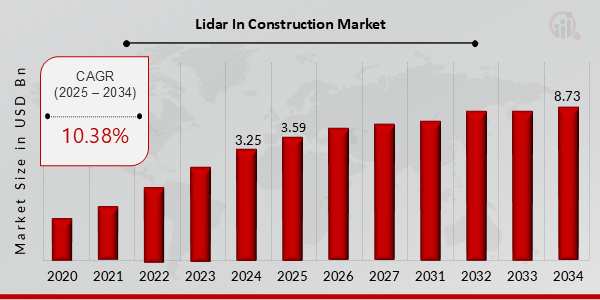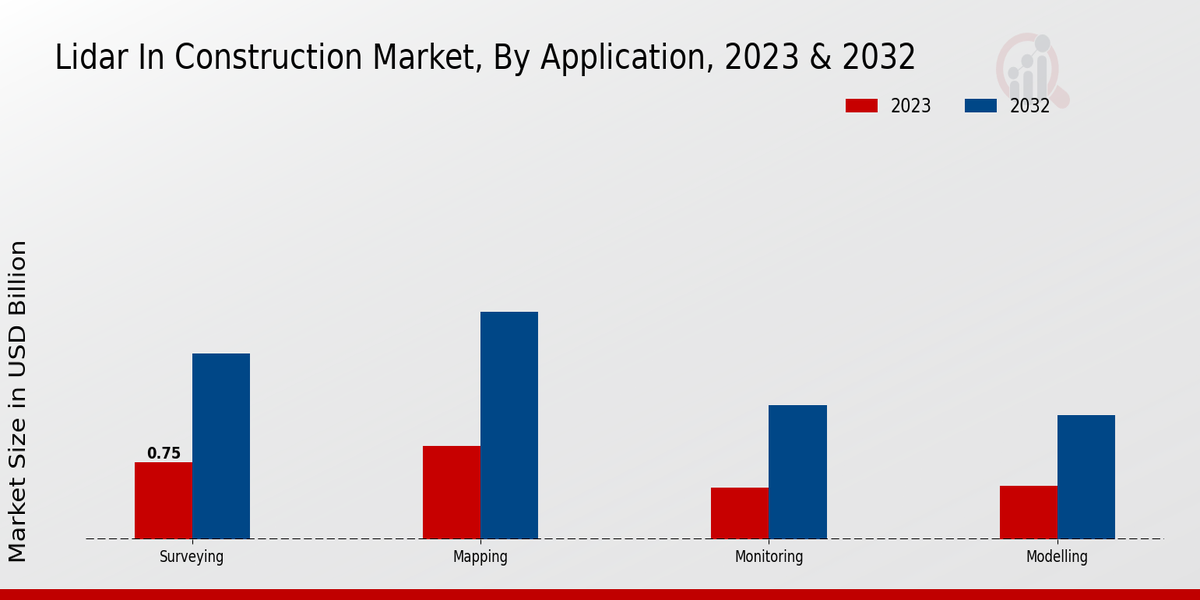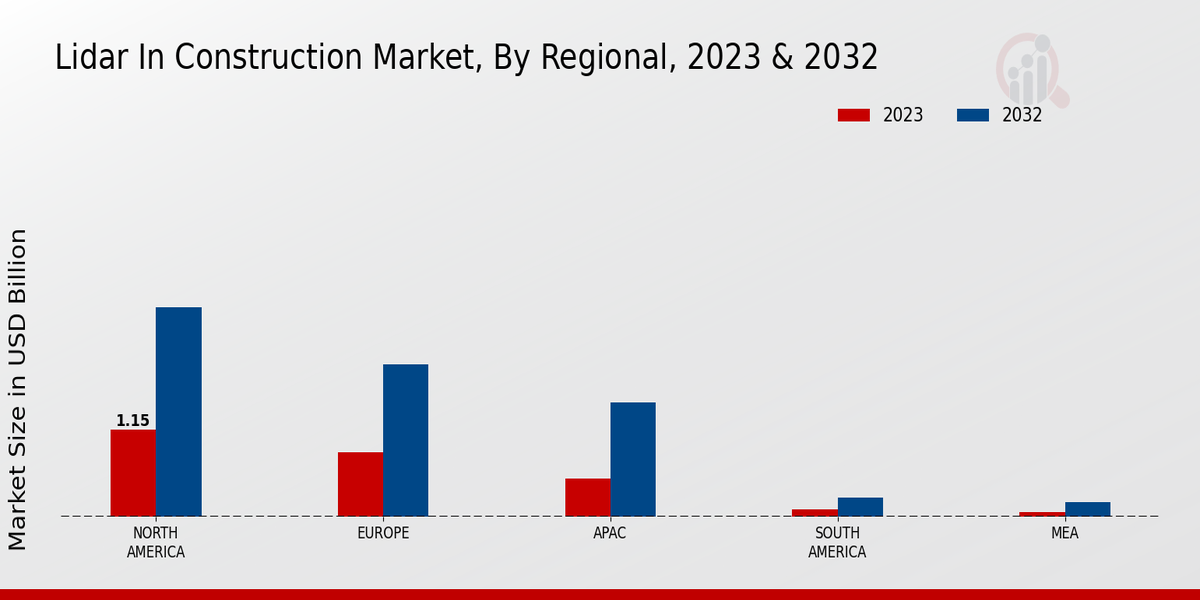Global LiDAR in Construction Market Overview
Lidar In Construction Market Size was estimated at 3.25 (USD Billion) in 2024. The Lidar In Construction Market Industry is expected to grow from 3.59 (USD Billion) in 2025 to 8.73 (USD Billion) till 2034, exhibiting a compound annual growth rate (CAGR) of 10.38% during the forecast period (2025 - 2034)
Key LiDAR in Construction Market Trends Highlighted
The Global LiDAR in Construction Market is experiencing notable growth driven by several key market drivers. The increasing demand for accurate and efficient surveying solutions has led to heightened adoption of LiDAR technology. As construction projects become more complex, the need for precise data is paramount. LiDAR offers improved visualization and analysis, allowing for better project planning and execution. Additionally, the integration of LiDAR with other technologies like drones and GPS has further enhanced its utility, streamlining workflows and reducing project timelines. The push for sustainability in construction is also propelling the use of LiDAR, as it helps optimize material use and minimize waste.
There are various opportunities to be explored within this market, particularly in emerging economies where infrastructure development is rapidly advancing. Adopting LiDAR technology can aid in the development of smart cities and sustainable urban planning initiatives. Additionally, the growth in the GIS market presents a chance for LiDAR solutions to be incorporated into various applications beyond traditional construction, including environmental monitoring and disaster management. The expanding scope of applications signifies a shift from conventional methods toward more innovative, data-driven approaches. Recent trends indicate a rising interest in autonomous and robotic systems that incorporate LiDAR, which can enhance safety and efficiency on construction sites.
As the construction industry embraces digital transformation, the reliance on advanced technologies like LiDAR is anticipated to grow. Furthermore, the introduction of software solutions that analyze LiDAR data is improving accessibility and usability for professionals, making it easier to interpret and apply the collected data for better project outcomes. This ongoing evolution highlights the increasing significance of LiDAR technology in shaping the future of construction.

Source: Primary Research, Secondary Research, MRFR Database and Analyst Review
LiDAR in Construction Market Drivers
Increasing Demand for Precision in Construction Projects
The Global LiDAR in Construction Market Industry is experiencing a significant surge in demand for precision and accuracy in construction projects. As construction projects grow in complexity and scale, the need for reliable and precise data has become paramount. LiDAR technology offers highly accurate measurements that capture detailed three-dimensional information about the physical environment. This capability enhances project planning, design, and implementation phases, ensuring that construction processes are efficient and run according to schedule.
The ability to map terrains and create detailed models of existing structures aids architects and engineers in making informed decisions, which minimizes errors and reduces the likelihood of costly rework or delays. Moreover, as stakeholders increasingly recognize the value of utilizing advanced technologies to streamline operations and enhance safety measures, the adoption of LiDAR continues to rise. In addition, the efficient data collection and real-time analysis capabilities provided by LiDAR systems empower construction teams to monitor progress continuously.
This ensures that projects not only adhere to timelines but also meet stringent quality standards. The transition from traditional methods to more tech-driven approaches in the industry reflects a broader trend of digitization within construction, further propelling growth in the Global LiDAR in the Construction Market Industry.
Government Initiatives and Funding
Government initiatives and funding play a pivotal role in driving the Global LiDAR in the Construction Market Industry. Many governments worldwide are increasingly investing in smart infrastructure and urban development projects, which leverage advanced technologies like LiDAR to facilitate better planning and resource management. As government funding is directed towards public infrastructure projects, the adoption of LiDAR technology gains momentum.
The enhanced accuracy and efficiency provided by LiDAR systems align with governmental goals for sustainable development, which further solidifies the technology's importance in contemporary construction projects. By promoting the integration of LiDAR in construction, governments not only enhance the quality of public infrastructure but also encourage the private sector to follow suit.
Technological Advancements in LiDAR Systems
Ongoing technological advancements in LiDAR systems significantly contribute to the growth of the Global LiDAR in the Construction Market Industry. Innovations in LiDAR technology, such as improvements in scanning speed, accuracy and data processing capabilities, make it an increasingly attractive option for construction projects. Modern LiDAR systems offer faster processing times and greater portability, allowing construction teams to use them in diverse environments and challenging terrains.
As the technology becomes more user-friendly and accessible, adoption rates continue to rise, leading to expanded applications in construction, including site surveying, design and monitoring.
LiDAR in Construction Market Segment Insights:
LiDAR in Construction Market Application Insights
The Global LiDAR in Construction Market has shown considerable growth, with the Application segment reflecting various key usages, including Surveying, Mapping, Monitoring and Modelling. In 2023, the overall market was valued at 2.67 USD Billion, highlighting a significant demand within construction applications. Among these applications, Surveying stands out with a valuation of 0.75 USD Billion in 2023 and is projected to grow to 1.8 USD Billion by 2032, demonstrating its critical role in the field, as accurate surveys are essential for any construction project’s foundation.
Mapping follows closely behind, valued at 0.9 USD Billion in 2023 and expected to reach 2.2 USD Billion by 2032; this application is vital for environmental assessments and project planning, driving much of the market's growth. Meanwhile, Monitoring holds a valuation of 0.5 USD Billion, growing to 1.3 USD Billion, as it plays a significant role in ensuring ongoing construction compliance and safety through continuous assessments. Modeling, although slightly less dominant with a current value of 0.52 USD Billion, is projected to rise to 1.2 USD Billion, highlighting the increasing importance of 3D models in visualizing construction projects and aiding decision-making processes.
These valuations and insights underscore the importance of the Application segment within the overall landscape, showcasing how Global LiDAR in Construction Market revenue is driven by these integral uses that enhance efficiency, safety, and accuracy in construction practices. With a high expected growth rate and increasing adoption of advanced technologies, the Global LiDAR in Construction Market segmentation reveals opportunities for innovation while also highlighting the challenges related to integration and technology costs that stakeholders must navigate.

Source: Primary Research, Secondary Research, MRFR Database and Analyst Review
LiDAR in Construction Market Technology Insights
The Global LiDAR in Construction Market is experiencing a notable rise, driven by advancements in technology and the increasing demand for precision in construction projects. Technology plays a pivotal role in this landscape, with various types, such as Terrestrial LiDAR, Aerial LiDAR, and Mobile LiDAR, each contributing to the overall market dynamics. Terrestrial LiDAR has emerged as a dominant force, facilitating high-resolution scans for complex structures, which is crucial for accurate modeling.
Aerial LiDAR is significant for large-area analysis and topographic mapping, enabling efficient surveying processes from above, while Mobile LiDAR enhances data collection capabilities in dynamic environments, making it essential for real-time updates on construction sites. These segments not only enhance efficiency but also address the growing challenges of accuracy and cost-effectiveness in the construction industry. The Global LiDAR in Construction Market data indicates that with increasing project complexity and the need for reliable data, these technologies are expected to witness substantial growth in the coming years.
Market statistics support the ongoing trend towards greater integration of LiDAR technology in construction processes, paving the way for innovative applications and improved project outcomes.
LiDAR in Construction Market End Use Insights
The Global LiDAR in Construction Market segments, Building Construction is crucial as it facilitates accurate project planning, design and execution, enhancing overall efficiency. Infrastructure Development also plays a prominent role by utilizing LiDAR technology for effective surveying and monitoring, which is essential for creating robust infrastructure.
Similarly, the Mining sector benefits markedly from LiDAR applications that enable better site analysis and resource management. The combination of these areas contributes to the overall growth and diversification of the market. Factors driving this growth include the increasing demand for precision, reduced project costs and enhanced safety in construction processes. However, challenges such as high initial investment costs and the need for skilled personnel may hinder market expansion. Nevertheless, emerging opportunities such as advancements in technology and increased awareness of LiDAR benefits are expected to further bolster the Global LiDAR in Construction Market revenue.
The overall market dynamics reflect attractive possibilities for continued innovation and adoption across these key sectors.
LiDAR in Construction Market Component Insights
The segment consists of vital elements such as Laser Scanners, GPS/INS systems and software solutions, each playing a significant role in the overall market landscape. Laser Scanners are pivotal, facilitating the generation of precise 3D models, enhancing project accuracy, and supporting efficient workflows. GPS/INS systems are crucial for improving geospatial data acquisition, ensuring accurate positioning and data reliability on construction sites.
Meanwhile, software solutions dominate the market by enabling seamless data processing and analysis, providing invaluable insights for project management and decision-making. With increasing construction projects embracing advanced technologies, the demand for these components is expected to grow steadily, reflecting the overall market trends and reinforcing the significance of the Global LiDAR in Construction Market data. The market growth is driven by the rising need for accuracy, efficiency, and safety in construction processes, while challenges include high initial investment and the need for skilled labor to operate these sophisticated systems.
Overall, the Global LiDAR in Construction Market segmentation reveals a dynamic interplay between these components, driving innovation and growth within the industry.
LiDAR in Construction Market Regional Insights
Among the regions, North America is the largest market, accounting for 1.15 USD Billion in 2023 and is set to grow to 2.75 USD Billion by 2032, reflecting its major share in market growth due to increased investment in construction technologies and infrastructure projects. Europe follows closely with a valuation of 0.85 USD Billion in 2023, expected to reach 2.0 USD Billion by 2032, driven by stringent regulations and advancements in automated construction techniques.
The APAC region is gaining momentum as well, with a market value of 0.5 USD Billion in 2023 projected to increase to 1.5 USD Billion by 2032, highlighting the rapid urbanization and infrastructure development in countries like China and India. South America and the MEA regions represent smaller segments, with valuations of 0.1 USD Billion and 0.07 USD Billion in 2023, respectively, reflecting limited adoption of advanced technology in construction but with growth potential as awareness increases. Overall, the Global LiDAR in Construction Market segmentation showcases diverse growth trajectories across regions, indicating significant opportunities for stakeholders.

Source: Primary Research, Secondary Research, MRFR Database and Analyst Review
LiDAR in Construction Market Key Players and Competitive Insights:
The Global LiDAR in the Construction Market is experiencing rapid growth as it revolutionizes the way construction projects are planned, executed and maintained. LiDAR technology enables accurate 3D mapping and modeling, which enhances the efficiency and effectiveness of construction operations. The competitive landscape is comprised of various players who are continually innovating and offering advanced solutions, leading to increased precision and reduced costs for stakeholders. As the construction industry seeks greater efficiency and accountability in project management, the deployment of LiDAR technology alongside traditional methodologies is becoming increasingly prevalent. The insights gathered from market competition reveal a dynamic environment where companies are striving for technological advancements, customer-centric solutions and strategic partnerships to capture a larger market share.
Faro Technologies has established a significant presence in the Global LiDAR Construction Market, offering a range of products and services tailored to the needs of construction professionals. The company's strengths lie in its advanced scanning technologies that provide high accuracy and detail in capturing building features and landscapes. Faro Technologies has cultivated a reputation for reliability and innovation, enabling it to gain trust among construction firms looking for effective ways to improve their workflows. The integration of Faro's solutions into construction projects not only accelerates measurement processes but also enhances data visualization, making it easier to communicate project details among stakeholders. Their commitment to continuous improvement and customer support further solidifies their position as a leader in this competitive market.
Velodyne Lidar is another prominent player in the Global LiDAR Construction Market, known for its cutting-edge sensor technology that facilitates precise measurements and real-time data acquisition. The company excels in creating high-resolution 3D maps that assist construction teams in making informed decisions throughout all phases of a project. Velodyne's strengths include its extensive experience and expertise in LiDAR technology, which allows it to develop solutions that meet the specific requirements of the construction industry. Furthermore, Velodyne’s proactive approach to research and development has led to a variety of versatile and scalable LiDAR solutions, providing clients with the tools needed to tackle complex construction challenges. This dedication to innovation and adaptability has positioned Velodyne as a key competitor in the growing LiDAR landscape within the construction sector.
Key Companies in the LiDAR Construction Market Include:
LiDAR in Construction Market Industry Developments
Recent developments in the Global LiDAR in Construction Market are shaping its trajectory significantly. Companies like Faro Technologies and Trimble are advancing their technological offerings, focusing on integrating AI capabilities for enhanced data processing efficiency. Velodyne Lidar has announced partnerships aimed at expanding its reach into new geographic markets, which is likely to increase competitive pressure in the sector. Leica Geosystems and Hexagon continue to focus on innovative product launches aimed at improving accuracy and reliability in surveying applications.
The market is witnessing consolidation, with recent merger and acquisition activity, although specific transactions involving companies such as Riegl and SenseFly have yet to be publicly announced. MQL Technology and Aeryon Labs are exploring collaboration opportunities to utilize drone technology in their LiDAR solutions, which could potentially revolutionize operational workflows in construction projects. Growth in market valuation is notable, as companies like Innoviz Technologies and Teledyne Technologies are expanding their portfolios, which in turn bolsters investment interest. This dynamic environment underscores the evolving requirements for accuracy, integration, and operational efficiency in LiDAR applications within the construction domain.
LiDAR in Construction Market Segmentation Insights
LiDAR in Construction Market Application Outlook
- Surveying
- Mapping
- Monitoring
- Modelling
LiDAR in Construction Market Technology Outlook
- Terrestrial LiDAR
- Aerial LiDAR
- Mobile LiDAR
LiDAR in Construction Market End Use Outlook
- Building Construction
- Infrastructure Development
- Mining
LiDAR in Construction Market Component Outlook
- Laser Scanner
- GPS/INS
- Software
LiDAR in Construction Market Regional Outlook
- North America
- Europe
- South America
- Asia Pacific
- Middle East and Africa
|
Report Attribute/Metric
|
Details
|
|
Market Size 2024
|
USD 3.25 Billion
|
|
Market Size 2025
|
USD 3.59 Billion
|
|
Market Size 2034
|
USD 8.73 Billion
|
|
Compound Annual Growth Rate (CAGR)
|
10.38% (2025-2034)
|
|
Base Year
|
2024
|
|
Market Forecast Period
|
2025-2034
|
|
Historical Data
|
2020-2023
|
|
Market Forecast Units
|
USD Billion
|
|
Report Coverage
|
Revenue Forecast, Competitive Landscape, Growth Factors, and Trends
|
|
Key Companies Profiled
|
Faro Technologies, Velodyne Lidar, Leica Geosystems, Riegl, SenseFly, MQL Technology, Topcon Corporation, Aeryon Labs, Trimble, Innoviz Technologies, Teledyne Technologies, Lynx Software Technologies, Quanergy Systems, Hexagon
|
|
Segments Covered
|
Application, Technology, End Use, Component, Regional
|
|
Key Market Opportunities
|
Increased adoption of automation,
Integration with BIM technology,
Growth in smart city initiatives,
Rising demand for project efficiency,
Advancements in LiDAR accuracy
|
|
Key Market Dynamics
|
Technological advancements in LiDAR,
Increasing demand for accuracy,
Cost-effectiveness of LiDAR solutions,
Growing adoption in infrastructure projects,
Enhanced data analysis capabilities
|
|
Countries Covered
|
North America, Europe, APAC, South America, MEA
|
Frequently Asked Questions (FAQ) :
The Global LiDAR in Construction Market was expected to be valued at 8.73 USD Billion by 2034.
The Global LiDAR in Construction Market is expected to grow at a CAGR of 10.38% from 2025 to 2034.
North America is projected to have the largest market share, valued at 2.75 USD Billion by 2032.
The market value for LiDAR applications in Mapping is expected to reach 2.2 USD Billion by 2032.
Key players in the market include Faro Technologies, Velodyne Lidar, Leica Geosystems, and Trimble, among others.
The estimated market value for LiDAR in the Monitoring sector is expected to be 1.3 USD Billion by 2032.
The Global LiDAR in Construction Market in Europe is expected to grow to 2.0 USD Billion by 2032.
The projected value for LiDAR applications in Surveying is expected to reach 1.8 USD Billion by 2032.
The market size of LiDAR in the APAC region is expected to reach 1.5 USD Billion by 2032.
The market may face challenges such as technological integration and competition from alternative surveying technologies.

















